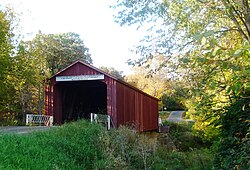2020 census
Bureau County, Illinois – Racial and ethnic composition
Note: the US Census treats Hispanic/Latino as an ethnic category. This table excludes Latinos from the racial categories and assigns them to a separate category. Hispanics/Latinos may be of any race.| Race / Ethnicity (NH = Non-Hispanic) | Pop 1980 [16] | Pop 1990 [17] | Pop 2000 [18] | Pop 2010 [19] | Pop 2020 [20] | % 1980 | % 1990 | % 2000 | % 2010 | % 2020 |
|---|
| White alone (NH) | 38,085 | 34,389 | 33,196 | 31,473 | 28,511 | 97.37% | 96.36% | 93.50% | 89.98% | 85.76% |
| Black or African American alone (NH) | 43 | 50 | 110 | 191 | 259 | 0.11% | 0.14% | 0.31% | 0.55% | 0.78% |
| Native American or Alaska Native alone (NH) | 125 | 61 | 53 | 63 | 49 | 0.32% | 0.17% | 0.15% | 0.18% | 0.15% |
| Asian alone (NH) | 52 | 182 | 181 | 220 | 298 | 0.13% | 0.51% | 0.51% | 0.63% | 0.90% |
| Native Hawaiian or Pacific Islander alone (NH) | x [21] | x [22] | 10 | 6 | 21 | x | x | 0.03% | 0.02% | 0.06% |
| Other race alone (NH) | 0 | 3 | 6 | 4 | 51 | 0.00% | 0.01% | 0.02% | 0.01% | 0.15% |
| Mixed race or Multiracial (NH) | x [23] | x [24] | 215 | 326 | 960 | x | x | 0.61% | 0.93% | 2.89% |
| Hispanic or Latino (any race) | 809 | 1,003 | 1,732 | 2,695 | 3,095 | 2.07% | 2.81% | 4.88% | 7.70% | 9.31% |
| Total | 39,114 | 35,688 | 35,503 | 34,978 | 33,244 | 100.00% | 100.00% | 100.00% | 100.00% | 100.00% |
As of the 2020 census, the county had a population of 33,244. The median age was 44.8 years. 21.2% of residents were under the age of 18 and 22.4% of residents were 65 years of age or older. For every 100 females there were 97.6 males, and for every 100 females age 18 and over there were 95.5 males age 18 and over. [25] [26]
The racial makeup of the county was 88.3% White, 0.8% Black or African American, 0.4% American Indian and Alaska Native, 0.9% Asian, 0.1% Native Hawaiian and Pacific Islander, 3.3% from some other race, and 6.2% from two or more races. Hispanic or Latino residents of any race comprised 9.3% of the population. [26]
45.0% of residents lived in urban areas, while 55.0% lived in rural areas. [27]
There were 14,179 households in the county, of which 26.4% had children under the age of 18 living in them. Of all households, 47.4% were married-couple households, 19.4% were households with a male householder and no spouse or partner present, and 25.5% were households with a female householder and no spouse or partner present. About 31.7% of all households were made up of individuals and 15.2% had someone living alone who was 65 years of age or older. [25]
There were 15,616 housing units, of which 9.2% were vacant. Among occupied housing units, 74.8% were owner-occupied and 25.2% were renter-occupied. The homeowner vacancy rate was 1.8% and the rental vacancy rate was 7.1%. [25]
2010 census
As of the 2010 United States census, there were 34,978 people, 14,262 households, and 9,605 families residing in the county. [28] The population density was 40.2 inhabitants per square mile (15.5/km2). There were 15,720 housing units at an average density of 18.1 per square mile (7.0/km2). [9] The racial makeup of the county was 94.2% white, 0.7% Asian, 0.6% black or African American, 0.3% American Indian, 3.0% from other races, and 1.3% from two or more races. Those of Hispanic or Latino origin made up 7.7% of the population. In terms of ancestry, 32.8% were German, 13.8% were Irish, 12.1% were English, 9.2% were American, 8.8% were Italian, 7.6% were Swedish, and 5.8% were Polish. [29]
Of the 14,262 households, 29.8% had children under the age of 18 living with them, 53.6% were married couples living together, 9.2% had a female householder with no husband present, 32.7% were non-families, and 28.0% of all households were made up of individuals. The average household size was 2.42 and the average family size was 2.94. The median age was 42.5 years.
The median income for a household in the county was $45,692 and the median income for a family was $55,217. Males had a median income of $42,327 versus $29,210 for females. The per capita income for the county was $24,103. About 8.6% of families and 11.1% of the population were below the poverty line, including 15.3% of those under age 18 and 7.5% of those age 65 or over. [30]




